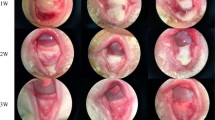Abstract
Introduction
The clinical pattern of corneal calcification has been considered to be a part of chronic eye diseases, such as uveitis, severe glaucoma, keratitis and eye burns. Since, in some cases of eye burns, we have found corneal calcifications to be related to the initial calciferous caustic agents and to the use of phosphate-buffer-containing fluids, we have reviewed our files of clinical eye burns for the incidence and appearance of corneal calcification.
Methods
A total of 176 burnt eyes of 98 patients suffering from severe eye burns were retrospectively reviewed. The following data set was acquired: the type of caustic agent, the time of the burns, the delay and type of immediate treatment and the time and type of first aid, the subsequent medication, the clinical grading and the later results.
Results
Calciferous burning agents and corneal calcification are correlated (P<0.01). Initial single rinsing with phosphate does not produce corneal calcification (P=0.134). There is evidence that corneal calcifications are correlated with chronically administered phosphate-buffered eye drops (P<0.005).
Discussion
Eye burns followed by calcifications follow two different major patterns: the corrosive substance contained calcium or the continued therapy was applied with phosphate-buffered eye drops. We present case reports of three different types of eye burns and later therapy resulting in corneal calcification. Corneal calcifications are presumably related to longer-lasting phosphate application. One suspicious mechanism is the low content of calcium ion stabilizing proteins such as hyaluronate or fetuin in treatments for severe eye burns. The exceeding of the solubility product of Ca2+ and PO4− results in the precipitation of calcium phosphates. In cases of chronic corneal disturbance, we recommend the elimination of phosphate-buffered medications to prevent corneal calcification.




Similar content being viewed by others
References
Bonafonte S, Fernandez del Cotero JN, Aguirre Vila-Coro A (1988) Mineral analysis in experimental corneal scars. An EDAX study. Cornea 7(2):122–126
Campos M, Nielsen S, Szerenyi K, Garbus JJ, McDonnell PJ (1993) Clinical follow-up of phototherapeutic keratectomy for treatment of corneal opacities. Am J Ophthalmol 115(4):433–440
Dolder R (1990) Ophthalmika. Wissenschaftlicher Verlagsgesellschaft, Stuttgart
Huige WM, Beekhuis WH, Rijneveld WJ, Schrage N, Remeijer L (1991) Deposits in the superficial corneal stroma after combined topical corticosteroid and beta-blocking medication. Eur J Ophthalmol 1(4):198–199
Huige WM, Beekhuis WH, Rijneveld WJ, Schrage N, Remeijer L (1991) Unusual deposits in the superficial corneal stroma following combined use of topical corticosteroid and beta-blocking medication. Doc Ophthalmol 78(3–4):169–175
Jahnen-Dechent W, Schafer C, Heiss A (2001) Grotzinger: systemic inhibition of spontaneous calcification by the serum protein alpha 2-HS glycoprotein/fetuin. Z Kardiol 90(Suppl 3):47–56
Langefeld S, Reim M, Redbrake C, Schrage NF (1997) The corneal stroma: an inhomogeneous structure. Graefe Arch Clin Exp Ophthalmol 235(8):480–485
McDonnell JM, Garbus JJ, McDonnell PJ (1992) Unsuccessful excimer laser phototherapeutic keratectomy. Clinicopathologic correlation. Arch Ophthalmol 110(7):977–979
Schirner G, Schrage NF, Salla S, et al (1990) Corneal silver deposits following Crede’s prophylaxis: an examination with electron dispersive X-ray analysis (EDX-analysis) and scanning electron microscope (SEM). Lens Eye Toxic Res 7(3–4):445–457
Schirner G, Schrage NF, Salla S, Reim M, Burchard WG (1995) Conjunctival tissue examination in severe eye burns: a study with scanning electron microscopy and energy-dispersive X-ray analysis. Graefe Arch Clin Exp Ophthalmol 233(5):251–256
Schrage NF, Flick S, Redbrake C, Reim M (1996) Electrolytes in the cornea: a therapeutic challenge [published erratum in Graefes Arch Clin Exp Ophthalmol 1997 Apr;235(4):262]. Graefe Arch Clin Exp Ophthalmol 234(12):761–764
Schrage NF, Reim M, Burchard WG (1990) Particulate matter contamination in the corneal stroma of severe eye burns in humans. Lens Eye Toxic Res 7(3–4):427–444
Schrage NF, Schloßmacher B, Aschenbrenner W, Langefeld S (2001) Phosphate buffer in alkali eye burns as an inducer of experimental corneal calcification. Burns 27(5):459–464
Taravella MJ, Stulting RD, Mader TH, Weisenthal RW, Forstot SL, Underwood LD (1994) Calcific band keratopathy associated with the use of topical steroid-phosphate preparations. Arch Ophthalmol 112(5):608–613
Von Fischern T, Lorenz U, Burchard WG, Reim M, Schrage NF (1998) Changes in mineral composition of rabbit corneas after alkali burn. Graefe Arch Clin Exp Ophthalmol 236(7):553–558
Author information
Authors and Affiliations
Corresponding author
Rights and permissions
About this article
Cite this article
Schrage, N.F., Kompa, S., Ballmann, B. et al. Relationship of eye burns with calcifications of the cornea?. Graefe's Arch Clin Exp Ophthalmol 243, 780–784 (2005). https://doi.org/10.1007/s00417-004-1089-2
Received:
Accepted:
Published:
Issue Date:
DOI: https://doi.org/10.1007/s00417-004-1089-2




